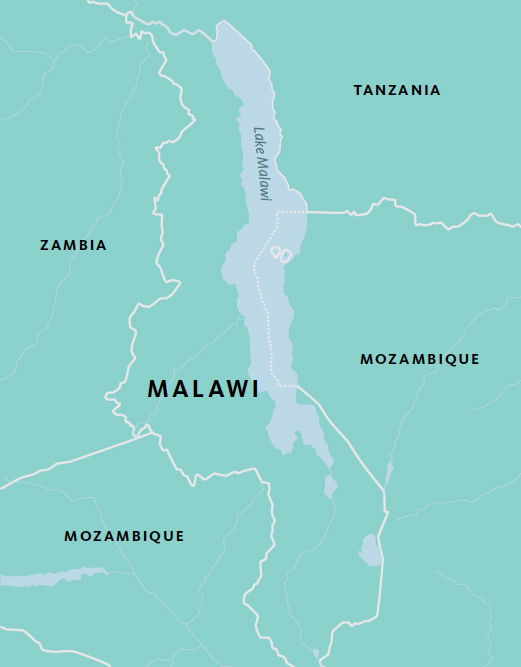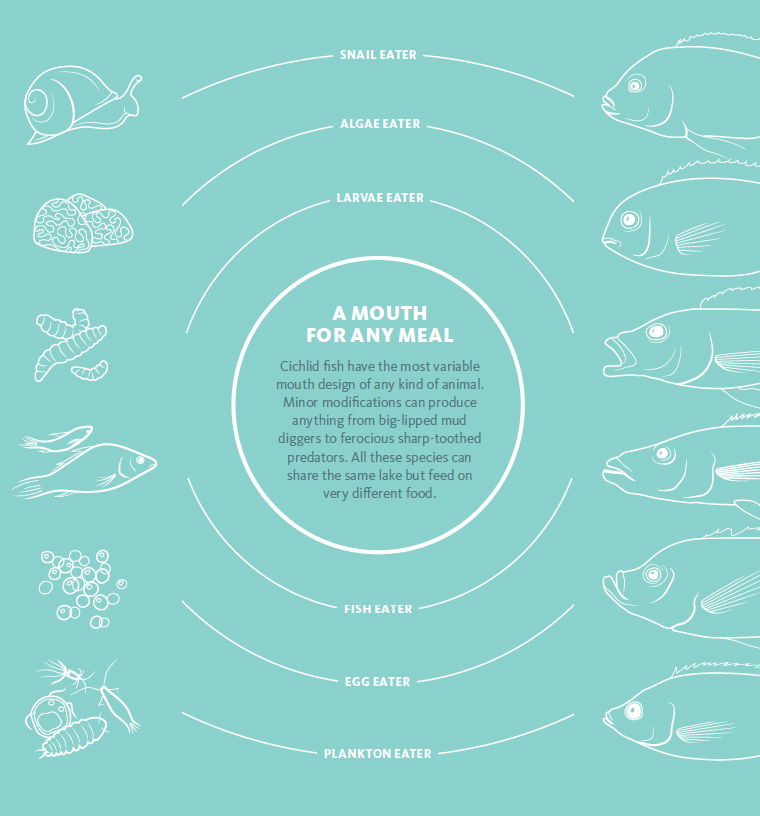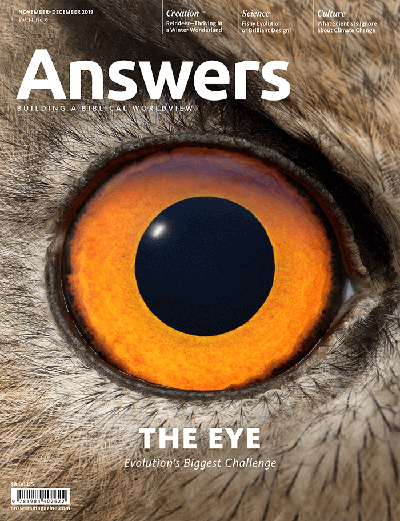Cichlid Variety—Fishy Evolution
Though a mystery to evolutionists, the incredible variety of cichlid fish showcases the Creator’s brilliant design for His creatures to diversify.
As a young boy, I loved animals and had many pets. Along with my beloved Boston terriers and Australian sheepdog mutt, I kept an assortment of hamsters, toads, snakes, turtles, salamanders, fish, and crawdads, all happily housed in an array of aquariums and containers that lined my room. Some of my best childhood memories are visits to a nearby series of ponds in central Florida where I quietly fished, observed the wildlife, and constantly added new and interesting creatures to my collection. The neighbors called me “snake boy” because I was always happy to rescue snakes from their swimming pools.
During this childhood fascination with God’s amazing creation, I purchased an oscar fish at the local pet store. This was my first introduction to a species of cichlid fish.
Many years later, my childhood interests blossomed into the focused study of marine invertebrates. My special passion was understanding how organisms interact in closed communities, such as salt and freshwater ponds and lakes, and how so much diversity can arise in confined areas. In college I learned that one of the most valuable “classrooms” for studying how species diversify is a series of lakes and rivers in eastern Africa. And the object lessons are—you guessed it—cichlid fish.
Beautiful, strange, intelligent, and tasty—cichlids display diversity to a degree that is almost unmatched in nature. One out of ten fish species are cichlids, and that’s a lot because fish account for half of all vertebrate species on the planet.
If you’re not familiar with the term cichlid (pronounced SI-kluhd), you’re still familiar with the fish itself. You might not keep an oscar or angelfish in your home aquarium, but you run into another cichlid species in the frozen food section of your local grocery store—tilapia. In fact, this delicious cichlid is one of the most widely raised fish on the planet, popular among fish farmers because it eats almost anything, grows quickly, and tolerates overcrowding and murky water.
Angelfish, oscars, and tilapia—such diversity! In one lake alone, Lake Malawi, scientists have found nearly 1,000 species of cichlids. More amazingly, the fish in Lake Malawi share the same watery environment, not separate islands. How could all this diversity arise in such close quarters?
My professors taught that cichlids prove evolution’s amazing power, but they couldn’t explain how the cichlids speciate so quickly. They still can’t. God’s Word points to a different—and much more reasonable—explanation.

Lake Malawi, Africa’s second-largest lake, is home to more fish species than any other lake on earth. Scientists are still trying to understand how this is possible.
My, What Big Lips You Have
The hardiness of tilapia helps explain why cichlids are so prolific, but that doesn’t explain their diversity. In fulfilling God’s command to be fruitful and multiply, cichlids show a knack for filling many unique and challenging underwater environments with flair. They range from tiny bottom-feeders that scour the lake floor 1,000 feet down with vacuum-cleaner mouths, to huge, long-toothed wolf cichlids that prowl the surface hunting for unsuspecting prey. Their outward appearance is just as diverse as their behavior, sporting every color under the sun. They can be striped (from head to tail), barred (from top to bottom), spotted, or plain.
With their many differences in form and function, you might wonder what unifying trait makes a cichlid a cichlid. They share one thing in common, but even that feature is highly adaptable. Like some other fish, they have two sets of jaws, one inside the other. But the second set (called pharyngeal jaws) can morph into vastly different shapes. This extra set of jaws aids their specialized mouths in grabbing and gobbling meals of every imaginable kind, from mud and algae to leaves, mollusks, and even scales that they scrape off other fish.
The big lips of some bottom-feeders, called hypertrophied lips, aren’t just for show. Scientists have identified several benefits, such as a larger surface for sensory nerves, more taste buds, and improved suction.
Observation and study show us that cichlids can eat almost anything, anywhere in the lake, but how are such sophisticated mouths in different species constructed from one original design?
A Mouth for Every Meal
Cichlid fish have the most variable mouth design of any kind of animal. Minor modifications can produce anything from big-lipped mud diggers to ferocious sharp-toothed predators. All these species can share the same lake but feed on very different food.

Snail Eater:
The powerful
beak-like mouth
and large teeth
of Trematocranus can crush the
hard shells of
snails.
Algae Eater: To scrape
algae off rocks,
Pseudotropheus has flat ripping
teeth on its
sloping, flat face.
Larvae Eater:
The big lips of
Melanochromis allow it to create
a seal over rocky
crevices and
suction up any
insect larvae.
Fish Eater:
Predators need
slim torpedolike
bodies and
large mouths
to swallow
their prey. No
problem for
Ramphochromis.
Egg Eater:
Its upturned
mouth, with a
longer lower
jaw, allows
Caprichromis to
ram brooding
fish from below,
forcing them to
spit out their eggs.
Plankton Eater:
Copadichromis
looks like a normal
fish, but unlike
other fish, it sticks
out an extra set
of jaws to suck up
zooplankton while
swimming.
An Ongoing Puzzle
Exactly how could a few ancestral species of cichlids produce so many different species with such varied colors, patterns, mouth shapes, and other body parts?
Ever since Darwin’s day, evolutionists have puzzled over the precise process of evolution. With the arrival of modern genetics, biologists have been able to gather much more detail, but the puzzle of evolution continues. Exactly how could a few ancestral species of cichlids produce so many different species with such varied colors, patterns, mouth shapes, and other body parts?
The new species have appeared too quickly for evolution to explain. Some of the African lakes are only a few thousand years old, even according to evolutionary measures. They believe Lake Malawi, for instance, may be only 40,000 years old. We know from Scripture it’s less than 6,000 years old, but even with 40,000 years, random mutations and natural selection can’t produce a thousand species. Even the most generous claims for evolution’s rate could not produce all those species in 100 times that number of years.
To find the secret, researchers are sequencing the different species’s DNA and trying to isolate some of the genes responsible for these changes. They are having some success, but the overall picture is still cloudy. For instance, they’ve looked at the genetic differences between species and concluded that the DNA must change more quickly in cichlids than most vertebrates (including a faster mutation rate and gene duplication). But that doesn’t solve the question of how such rapid speciation could occur.
There is no evidence of randomness to produce such well-designed lake feeders. And the changes have occurred so recently that each species can still hybridize (mate with other species) if isolated in an aquarium without the option of mating with its own species. Actually, the power of hybridization to produce species quickly is another idea that is gaining popularity among biologists. This has even been covered in Answers magazine (“The Great Species Mix-up,” Nov.–Dec. 2017). A summary of a recent article in Science journal at sciencemag.org, explains the latest thinking:
Hybridization, once considered detrimental, can boost a species’s evolutionary potential. . . . Cichlid genomes have been mixed and matched in different ways over time with various descendants being repeatedly separated and united . . . [producing] extensive genetic diversity that fueled rapid speciation.1
The problem for evolutionists is that the potential variety already exists within the original pair of species. Recent studies of cichlid DNA in the nearby Congo River drainage system indicates that at some point (or points) in the past, the water from both river systems merged long enough for fish from both regions to breed and exchange DNA quickly.
The original cichlids already had the necessary programming to support marvelous variations to fill many niches. But they are still cichlids.
Again, this means the variation was in the system to begin with. The original cichlids already had the necessary programming to support marvelous variations to fill many niches. But they are still cichlids; they still share the same basic jaw parts, color templates, and pattern options. It is fascinating to study how cichlids adapt based on this variable programming, but it doesn’t prove cichlids produce anything other than cichlids. It looks as though the cichlids’ flexibility was designed that way from the start.
Wallace’s Line in the Water
This conundrum brings to my mind one of the most influential founders of modern evolutionary beliefs, a contemporary of Charles Darwin named Alfred Wallace. While Darwin studied the animals on the Galápagos Islands near South America, Wallace studied wildlife on the islands of Malaysia, Indonesia, and especially New Guinea. Unlike Darwin, Wallace believed that the environment was the primary driver of speciation, not competition between individuals. He is famous for drawing a line in the map of Southeast Asia, delineating where deep ocean water separates the species throughout western Indonesia from the completely unrelated species in New Guinea and other islands connected to the Australian continental landmass.
The rapid cichlid speciation in Lake Malawi, however, forces us to reconsider the driving force at the heart of Wallace’s view. There are no geographical barriers in Lake Malawi.
I have thought about Wallace often, as I’ve spent the last 15 years deep in the uncharted rainforests of New Guinea. In fact, as I write this article in my humble island home off the coast of the vast New Guinea mainland, I can look across the strait to the north and see the very village where Wallace lived, observed birds and insects, and formed his views about evolution nearly 170 years ago.
Both Wallace and Darwin attempted to explain how natural selection (among other variables and pressures) could cause small changes in animals that would eventually build up and complement each other, leading to similar yet new species of animals. Wallace believed environmental factors like a landslide could separate a small population from the rest of its kin. This isolation would allow the cut-off group to reproduce separately from the original population. Due to inbreeding of this small population, small differences in traits would be emphasized and lead to a new “species.” But that explanation is insufficient because cichlid species usually live in the same African lake with no observable or understandable barriers to explain their existence.

Cichlids in Lake Malawi have speciated to showcase an amazing variety of colors and markings.
The Solution to the Puzzle
Careful research has made clear the facts we can all agree on. Cichlids have speciated into an amazing variety through slight changes to their appearance, such as color and stripes, and even their behavior. But is this really evolution, as Wallace and Darwin described? Does this give evidence that small changes over time could produce something other than a cichlid? Definitely not!
When we look at God’s message in the book of Genesis, we see the Creator’s simple explanation that cuts through the chaos and clearly illuminates what we see today. In Genesis 1:22 God commanded the fish and other marine life to be fruitful and multiply, and he put in their genetics the diversity to do just that. He created these creatures “according to their kinds” (Genesis 1:21), which means they were designed to reproduce within the limits of their kind.
From Genesis 1 we know that God specially made the original cichlid ancestors on the fifth day of creation. From there, they multiplied, changing in small ways as they filled the earth’s waterways. During the catastrophic flood of Noah’s day, some fish died, but some varieties survived to multiply into what we see today. In closed systems like Lake Malawi in Africa, we get to observe this rapid variation even today, as cichlids fill many niches.
Scientists are still sorting out the details about how the variations arise, whether by mutations, hybridization, or a combination of these and many other factors. But one thing is clear. In spite of their marvelous variety, cichlids still breed with other cichlids and produce only cichlids. The rapid variation of cichlids (no matter what genetic mechanism is at play) could never change them into a completely different kind of animal.
What can be dizzying to the evolutionist is reassuring to the creationist like myself. All organisms in the world, from butterflies and beetles to snakes and fish, are faithful to God’s command to spread out and fill the earth, but only to the biological limits he created within them.
African cichlids are touted as a showcase for naturalistic evolution, but if you look closer, they actually showcase the Creator’s glory. He specially created these fish for our pleasure, whether we casually observe their outward beauty in our aquariums, relish their flavor at dinnertime, or wonder at their biological makeup in the lab. We clearly see the Creator’s forethought, design, and order.
Related Videos
The Wild Brothers: Paradise Lost (Excerpt)
Answers Magazine
November–December 2019
Don’t look now, but you’re being watched by an amazing variety of magnificent eyes.
Browse Issue SubscribeFootnotes
- Elizabeth Pennisi, “Hybrids Spawned Lake Victoria’s Rich Fish Diversity,” Abstract, Science 361, no. 6402 (August 2018).
Recommended Resources

Answers in Genesis is an apologetics ministry, dedicated to helping Christians defend their faith and proclaim the good news of Jesus Christ.
- Customer Service 800.778.3390
- © 2024 Answers in Genesis






